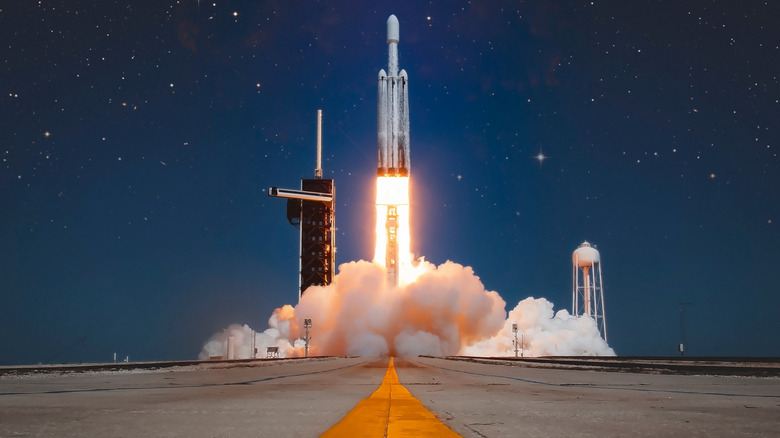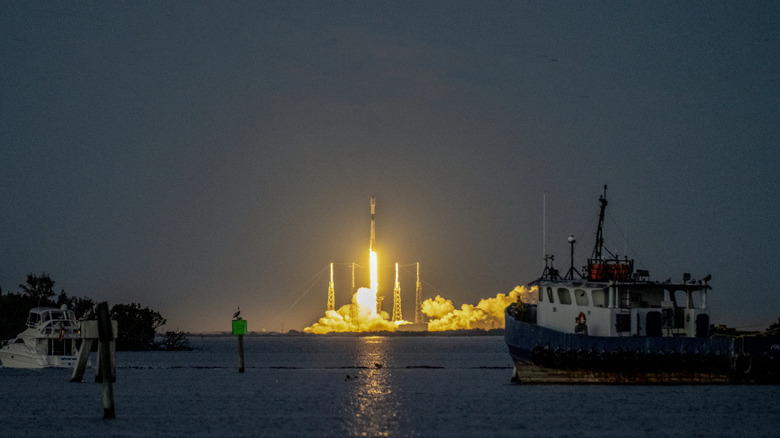Here's How Much It Costs For One Of Elon Musk's Rockets To Launch
There was a time when space was under the unique purview of governments rather than private companies. Although corporations have been involved in space exploration since the beginning of the space age in the mid-50s, it wasn't until 1982 when the first private rocket was successfully launched into space by Space Services Inc. Since then things have ramped up significantly, with the private sector becoming increasingly involved in space travel and exploration.
In the United States, the Commercial Space Launch Amendments Act, designed to promote the development of commercial human space flight, was passed in 2004. As a 2005 article in the Journal of Space Law noted, prior to the act, human space flight was mostly limited to government-sponsored astronauts using government-owned, -funded and -operated crafts. But following the passage of the act, that all changed. In 2004, Scaled Composites, LLC launched and successfully returned the first privately built and operated manned rocket more than 100 kilometers (62 miles) above Earth's surface. As article author Timothy Robert Hughes wrote, "space travel may have entered a new era in which private entities, rather than national governments, regularly, safely and affordably transport people into space."
Almost two decades later, Hughes' predictions have proven accurate as private space exploration has become widespread. We've also seen major collaborations between the private and public sector in that regard, such as Planet Labs' satellites that provide high resolution imagery of our planet and NASA's Commercial Crew Program, which has seen the agency collaborate with SpaceX and Boeing to reduce the cost of transporting astronauts to the International Space Station. SpaceX's reusable rocket technology has been a big factor in this equation, and as anyone who's been paying attention in recent years will know, the company has been working hard on developing that technology with numerous test launches. But as you might expect, those launches don't come cheap — though they're a lot cheaper than the alternatives.
The cost of SpaceX launches is high, but not as high as others
According to NASA, in 2018 SpaceX advertised its Falcon 9 rocket cost $62 million to reach low earth orbit (the area of the Earth's atmosphere below 1,200 miles, where artificial satellites are typically sent). Falcon heavy launches were more expensive, coming in at $90 million, and a human-crewed Falcon 9 and Dragon capsule mission to the ISS was about $140 million. In 2022, however, SpaceX increased its prices for launches across the board. Falcon 9 and Falcon Heavy launches both increased by 8%, taking the former to $67 million and the latter to $97 million. Elon Musk cited "significant recent inflation pressure in raw materials & logistics" as the reason for the price hike.
That might seem like a heck of a lot of money, and there's no doubt it is in the grand scheme of things. But it's also significantly cheaper than NASA's launch attempts (which also involve using half a million gallons water). According to the book "The Space Shuttle Decision," the 1969 launch of Apollo 11 cost an estimated $185 million ($1.62 billion, adjusted for inflation). What's more, the agency's space shuttle launches cost around $1.5 billion each to reach LEO. Put another way, it cost NASA $24,700/lb to put a crew into LEO whereas SpaceX does it for half the price at $10,500/lb.
With uncrewed missions the difference is even more stark. NASA currently uses Atlas V rockets to send cargo into orbit which cost around $2,600/lb to put something in LEO. Compare that to the Falcon Heavy which can do it for $635/lb, making NASA four times more expensive than SpaceX. When you look at it that way, SpaceX's launches are comparatively affordable and it's easy to see why the company has been so successful in landing government contracts.

